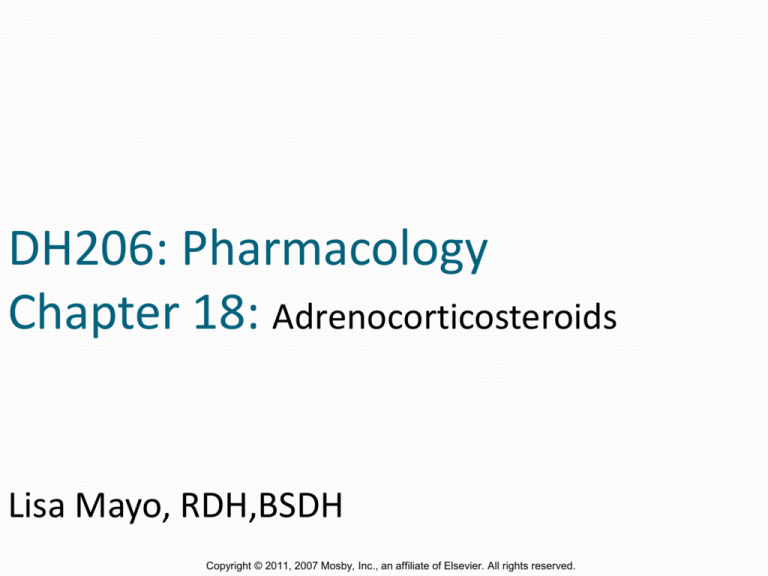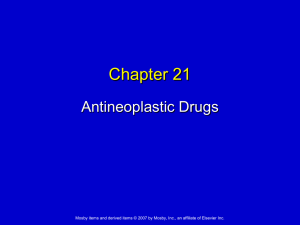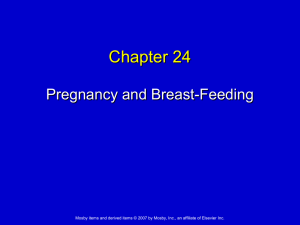
DH206: Pharmacology
Chapter 18: Adrenocorticosteroids
Lisa Mayo, RDH,BSDH
Copyright © 2011, 2007 Mosby, Inc., an affiliate of Elsevier. All rights reserved.
Chapter 19 Outline
A&P Review
Hormone Secretion
Classification
Route of Administration
Mechanism of Action
Pharmacological Effects
Adverse Rxns
Copyright © 2011, 2007 Mosby, Inc., an affiliate of Elsevier. All rights reserved.
Adrenocorticosteroids
Use in dentistry
Topically or systemically
Treatment of oral lesions associated with inflammatory
disorders
Long-term therapy: asthma or arthritis
Copyright © 2011, 2007 Mosby, Inc., an affiliate of Elsevier. All rights reserved.
A&P Review
http://www.youtube.com/watch?v=fF_3mJV3Yh0
Copyright © 2011, 2007 Mosby, Inc., an affiliate of Elsevier. All rights reserved.
A&P Review
Adrenal glands located on upper surface
of each kidney
Outer (next slide) & Inner layer
Inner layer (adrenal medulla)
Secretes catecholamine’s during fightor-flight response
Epi is ONLY produced from the
adrenal medulla = responsible for
converting stored glycogen to glucose
(glycogenolysis)
Copyright © 2011, 2007 Mosby, Inc., an affiliate of Elsevier. All rights reserved.
A&P Review
Outer part: adrenal cortex has 3 layers
Each layer secretes steroid hormones
3 layers of the cortex
Layer of
Cortex
Location
Hormone
released
Function
Glomerulosa
Outer
Aldosterone
Acts on kidney to ↑ absorption Na+,
(mineralcortic dump K+ & H+
o-steroid)
Fasciculata
Middle
Cortisol
Reticularis
Inner
Sex androgens Male secondary characteristics
(testosterone) Women’s only source of androgens
Signals to body to ↑ glucose through
gluconeogenesis or glycogenolysis
Body secretes 20mg/day
Copyright © 2011, 2007 Mosby, Inc., an affiliate of Elsevier. All rights reserved.
A&P Review
Deficiency/Adrenal gland not working properly: Addison’s disease
Effects from the 3 layers of the adrenal gland
1.
Aldosterone deficiency: Increase K+, metabolic acidosis (H+ ↑),
↓Na+
2.
Cortisol deficiency: Inadequate secretion of glucocorticoids,
decrease glucose – when needed for flight or fight – will not have)
3.
Testosterone deficiency
Summary of what will happen to patient
Hyperkalemia (↑K+)
Low BP (due to Na drop)
Metabolic acidosis (H+ ↑)
Hypoglycemia (decrease glucose)
Copyright © 2011, 2007 Mosby, Inc., an affiliate of Elsevier. All rights reserved.
A&P Review
Too much hormone production from adrenal gland: Cushing’s Disease
Too much ACTH hormone from pituitary
Your book sometimes calls this Cushing’s syndrome: syndrome and disease
are very different. Syndrome usually occurs due to exogenous steroid use
Will see the opposite effects as Addison’s
Aldosterone: Decrease K+, H+, ↑Na+(↑ BP)
Cortisol: Hyperglycemia
Testosterone ↑ (secondary male characteristics) – exogenous steroids
can do this as well
Copyright © 2011, 2007 Mosby, Inc., an affiliate of Elsevier. All rights reserved.
A&P Review
Hypothalamic-Anterior Pituitary Axis
A complex set of direct influences & feedback interactions
among 3 endocrine glands
1.
Hypothalamus
2.
Pituitary gland
3.
Adrenal gland
Pituitary gland
Often called the “master gland” of the endocrine system
Controls many other glands
2 lobes
Located in the brain, attached to the hypothalamus
Hypothalamus controls the pituitary gland: connected by the
portal system called Hypothalamic-Ant Pit Axis (see net slide)
Copyright © 2011, 2007 Mosby, Inc., an affiliate of Elsevier. All rights reserved.
A&P Review
Hypothalamic-Anterior Pituitary Axis
Hypothalamus releases hormone CRH
↓
Acts on Pituitary gland
↓
ACTH hormone released
↓
Influence adrenal gland
↓
Can also have
a NEGATIVE
FEEDBACK
to help
regulate
hormone levels
Adrenal gland releases its 3 hormones
(aldosterone, cortisol, androgens)
SUMMARY: corticosteroids from adrenal gland controlled by
hypothalamus & pituitary gland
Copyright © 2011, 2007 Mosby, Inc., an affiliate of Elsevier. All rights reserved.
Copyright © 2011, 2007 Mosby, Inc., an affiliate of Elsevier. All rights reserved.
Hormone Secretion
Key Points
More cortisol & CRH are secreted during waking hours
When stressed – body needs more cortisol to cope
When level of cortisol rises above normal: ACTH/CRH release
is inhibited: called NEGATIVE FEEDBACK
Steroids act like endogenous cortisol – they inhibit release
ACTH/CRH
Long-term steroid use – ACTH release is suppressed for
long periods thus atrophy occurs to adrenal gland
If steroid is stopped abruptly – relative steroid deficiency
result – leads to adrenal crisis
Copyright © 2011, 2007 Mosby, Inc., an affiliate of Elsevier. All rights reserved.
Copyright © 2011, 2007 Mosby, Inc., an affiliate of Elsevier. All rights reserved.
DRUG CLASSIFICATION
Mineralocorticoids
Glucocorticoids
Copyright © 2011, 2007 Mosby, Inc., an affiliate of Elsevier. All rights reserved.
Classification
Glucocorticoids
1.
Stimulate gluconeogenesis (make glucose) & lipolysis (fat breakdown)
Inhibit glucose uptake by cells (to increase blood plasma glucose)
Tx of inflammatory or allergic conditions (Book focuses on this
category) – NEXT SLIDE
Drugs called corticosteroids
Mineralocorticoids (Aldosterone)
2.
Affect kidney: water & electrolyte composition
Act on kidney in Loop of Henle
Useful for patient with kidney issues
Protype: fludrocortisone(Florinef)
Copyright © 2011, 2007 Mosby, Inc., an affiliate of Elsevier. All rights reserved.
Glucocorticoid Uses
MEDICAL USES
DENTAL USES
Asthma
Oral lesions
RA
Aphthous stomatitis
Lupus
TMD
Addison’s
Post-op surgery
Allergy
Burning tongue
Transplant rejection
Lichen planus
GI disorders (ulcerative
colitis, Crohns, IBD)
Copyright © 2011, 2007 Mosby, Inc., an affiliate of Elsevier. All rights reserved.
Glucocorticoid Uses
Antiinflammatory
Suppress immune responses
Palliative rather than curative
Copyright © 2011, 2007 Mosby, Inc., an affiliate of Elsevier. All rights reserved.
Glucocorticoid Administration
Topical
Useful for dental lesions
Oral
Parental (IM, IV)
Copyright © 2011, 2007 Mosby, Inc., an affiliate of Elsevier. All rights reserved.
Mechanism of Action Corticosteroids
Most potent antiinflammatory agents available
Almost every cell in the body has glucococortoid receptors
located in the cytoplasm
Cortisol (glucococortoid hormone) is hydrophobic – requires
active transport into a cell by a protein
Once inside the cell – travels to nucleus & binds to DNA
See next slide for picture
Copyright © 2011, 2007 Mosby, Inc., an affiliate of Elsevier. All rights reserved.
Active
Transport
Copyright © 2011, 2007 Mosby, Inc., an affiliate of Elsevier. All rights reserved.
Mechanism of Action Corticosteroids
Once inside cell
1.
2.
Controls rate of PRO synthesis
Controls release of histamine
Immunological Effects
↑ neutrophils
↓ inflammatory agents (prostaglandin, leukotriene,
macrophages)
Copyright © 2011, 2007 Mosby, Inc., an affiliate of Elsevier. All rights reserved.
Corticosteroid Drugs
Classified by duration of action – need to know which
drugs fall into each category
p. 217, Table 18-2 Do NOT use this list, use next slide
drugs..mistake in your book with Prednisone (listed as
short-acting but is intermediate)
Copyright © 2011, 2007 Mosby, Inc., an affiliate of Elsevier. All rights reserved.
Corticosteroid Drugs
Short-Acting
Cortisone(Cortone)
Hydrocortisone(Cortisol, Cortef)
Intermediate-Acting (Useful in Dentistry)
No
contraindications
for EPI in LA
Methylprednisolone(Medrol)
Prednisolone(Orapred, Prelone)
Prednisone(Meticorten, Deltasone)
1st line drug
Triamcinolone(Aristocort, Kenacort)
Long-Acting
Betamethasone(Celestone)
Dexamethasone(Decadron)
Copyright © 2011, 2007 Mosby, Inc., an affiliate of Elsevier. All rights reserved.
Adverse Rxns
Rare in short-term use
Long-term has many side effects due to suppression of
adrenal gland function
Metabolic changes (NBQ)
Moon face
Buffalo hump
Obesity, Weight gain
Copyright © 2011, 2007 Mosby, Inc., an affiliate of Elsevier. All rights reserved.
Adverse Rxns
Hyperglycemia (NBQ)
Hypertension
Osteoporosis
Mood/behavior changes
Poor-delayed healing
Immune suppression: Candidiasis, etc…
Peptic ulcers
Corticosteroids ↑production of stomach acid &
pepsin
No Aspirin & NSAIDs
Copyright © 2011, 2007 Mosby, Inc., an affiliate of Elsevier. All rights reserved.
Adverse Rxns
Adrenal crisis
Adrenal suppression with prolonged use (adrenal gland
told not to release ACTH/CRH because patient getting
from external source)
Body cannot respond correctly to stressful situation
Ex: dental phobia – steroid user body will not produce
enough cortisol to respond to pt’s increased anxiety –
crisis could occur
Pt may need additional steroids day of appt to
accommodate for this issue (Prednisone most commonly
given)
Copyright © 2011, 2007 Mosby, Inc., an affiliate of Elsevier. All rights reserved.
Drug Interactions
Drug interactions due to liver metabolism by the CYP3A4
enzyme
1) Insulin drugs
2) Carbamazepine(Tegretol)
3) Phenytoin(Dilantin)
4) Rifampin (TB drug)
5) Phenobarbital
Copyright © 2011, 2007 Mosby, Inc., an affiliate of Elsevier. All rights reserved.






